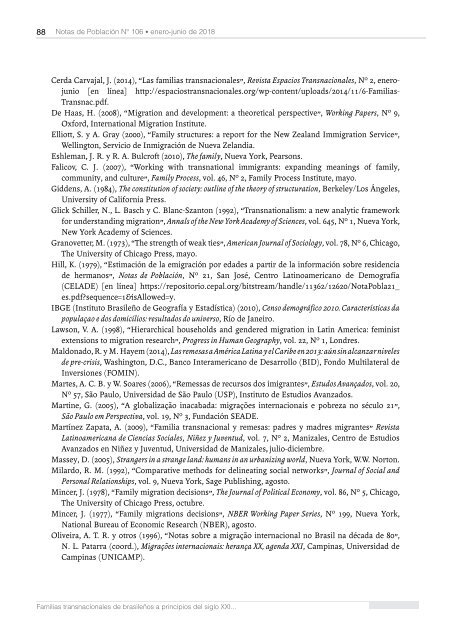Notas de Población N° 106
El número 106 de Notas de Población está conformado por 10 artículos, en cuya elaboración han participado 21 colaboradores. Los artículos abordan diversos temas de investigación relacionados con la mortalidad, el transnacionalismo migratorio y la fecundidad de las migrantes, así como la fecundidad adolescente, el femicidio, la migración de retorno, la segregación en el espacio urbano y el dividendo demográfico.
El número 106 de Notas de Población está conformado por 10 artículos, en cuya elaboración han participado 21 colaboradores. Los artículos abordan diversos temas de investigación relacionados con la mortalidad, el transnacionalismo migratorio y la fecundidad de las migrantes, así como la fecundidad adolescente, el femicidio, la migración de retorno, la segregación en el espacio urbano y el dividendo demográfico.
You also want an ePaper? Increase the reach of your titles
YUMPU automatically turns print PDFs into web optimized ePapers that Google loves.
88<br />
<strong>Notas</strong> <strong>de</strong> <strong>Población</strong> <strong>N°</strong> <strong>106</strong> • enero-junio <strong>de</strong> 2018<br />
Cerda Carvajal, J. (2014), “Las familias transnacionales”, Revista Espacios Transnacionales, Nº 2, enerojunio<br />
[en línea] http://espaciostransnacionales.org/wp-content/uploads/2014/11/6-Familias-<br />
Transnac.pdf.<br />
De Haas, H. (2008), “Migration and <strong>de</strong>velopment: a theoretical perspective”, Working Papers, Nº 9,<br />
Oxford, International Migration Institute.<br />
Elliott, S. y A. Gray (2000), “Family structures: a report for the New Zealand Immigration Service”,<br />
Wellington, Servicio <strong>de</strong> Inmigración <strong>de</strong> Nueva Zelandia.<br />
Eshleman, J. R. y R. A. Bulcroft (2010), The family, Nueva York, Pearsons.<br />
Falicov, C. J. (2007), “Working with transnational immigrants: expanding meanings of family,<br />
community, and culture”, Family Process, vol. 46, Nº 2, Family Process Institute, mayo.<br />
Gid<strong>de</strong>ns, A. (1984), The constitution of society: outline of the theory of structuration, Berkeley/Los Ángeles,<br />
University of California Press.<br />
Glick Schiller, N., L. Basch y C. Blanc-Szanton (1992), “Transnationalism: a new analytic framework<br />
for un<strong>de</strong>rstanding migration”, Annals of the New York Aca<strong>de</strong>my of Sciences, vol. 645, Nº 1, Nueva York,<br />
New York Aca<strong>de</strong>my of Sciences.<br />
Granovetter, M. (1973), “The strength of weak ties”, American Journal of Sociology, vol. 78, Nº 6, Chicago,<br />
The University of Chicago Press, mayo.<br />
Hill, K. (1979), “Estimación <strong>de</strong> la emigración por eda<strong>de</strong>s a partir <strong>de</strong> la información sobre resi<strong>de</strong>ncia<br />
<strong>de</strong> hermanos”, <strong>Notas</strong> <strong>de</strong> <strong>Población</strong>, Nº 21, San José, Centro Latinoamericano <strong>de</strong> Demografía<br />
(CELADE) [en línea] https://repositorio.cepal.org/bitstream/handle/11362/12620/NotaPobla21_<br />
es.pdf?sequence=1&isAllowed=y.<br />
IBGE (Instituto Brasileño <strong>de</strong> Geografía y Estadística) (2010), Censo <strong>de</strong>mográfico 2010. Características da<br />
populaçao e dos domicílios: resultados do universo, Río <strong>de</strong> Janeiro.<br />
Lawson, V. A. (1998), “Hierarchical households and gen<strong>de</strong>red migration in Latin America: feminist<br />
extensions to migration research”, Progress in Human Geography, vol. 22, Nº 1, Londres.<br />
Maldonado, R. y M. Hayem (2014), Las remesas a América Latina y el Caribe en 2013: aún sin alcanzar niveles<br />
<strong>de</strong> pre-crisis, Washington, D.C., Banco Interamericano <strong>de</strong> Desarrollo (BID), Fondo Multilateral <strong>de</strong><br />
Inversiones (FOMIN).<br />
Martes, A. C. B. y W. Soares (2006), “Remessas <strong>de</strong> recursos dos imigrantes”, Estudos Avançados, vol. 20,<br />
Nº 57, São Paulo, Universidad <strong>de</strong> São Paulo (USP), Instituto <strong>de</strong> Estudios Avanzados.<br />
Martine, G. (2005), “A globalização inacabada: migrações internacionais e pobreza no século 21”,<br />
São Paulo em Perspectiva, vol. 19, Nº 3, Fundación SEADE.<br />
Martínez Zapata, A. (2009), “Familia transnacional y remesas: padres y madres migrantes” Revista<br />
Latinoamericana <strong>de</strong> Ciencias Sociales, Niñez y Juventud, vol. 7, Nº 2, Manizales, Centro <strong>de</strong> Estudios<br />
Avanzados en Niñez y Juventud, Universidad <strong>de</strong> Manizales, julio-diciembre.<br />
Massey, D. (2005), Strangers in a strange land: humans in an urbanizing world, Nueva York, W.W. Norton.<br />
Milardo, R. M. (1992), “Comparative methods for <strong>de</strong>lineating social networks”, Journal of Social and<br />
Personal Relationships, vol. 9, Nueva York, Sage Publishing, agosto.<br />
Mincer, J. (1978), “Family migration <strong>de</strong>cisions”, The Journal of Political Economy, vol. 86, Nº 5, Chicago,<br />
The University of Chicago Press, octubre.<br />
Mincer, J. (1977), “Family migrations <strong>de</strong>cisions”, NBER Working Paper Series, Nº 199, Nueva York,<br />
National Bureau of Economic Research (NBER), agosto.<br />
Oliveira, A. T. R. y otros (1996), “<strong>Notas</strong> sobre a migração internacional no Brasil na década <strong>de</strong> 80”,<br />
N. L. Patarra (coord.), Migrações internacionais: herança XX, agenda XXI, Campinas, Universidad <strong>de</strong><br />
Campinas (UNICAMP).<br />
Familias transnacionales <strong>de</strong> brasileños a principios <strong>de</strong>l siglo XXI...


















